An Essay on the Challenges of Creating Effective Teams
VerifiedAdded on 2023/05/30
|13
|3904
|354
Essay
AI Summary
This essay delves into the multifaceted challenges encountered by managers in the process of building and sustaining effective teams. The study identifies various issues, including individual team members prioritizing personal recognition over collaboration, poor time management, dissatisfaction with task allocation, lack of acceptance of team leaders, technical expertise gaps, conflicts over ideas, and difficulties with pressure. For each of these challenges, the essay provides potential solutions, such as fostering individual motivation through tailored approaches, implementing time management strategies, ensuring fair task allocation, promoting effective communication, facilitating technical knowledge sharing, encouraging collaborative decision-making, and adapting to generational differences in work styles. The essay emphasizes the importance of addressing these issues to enhance team performance and overall organizational success, highlighting the need for proactive management strategies and a focus on individual and team needs.
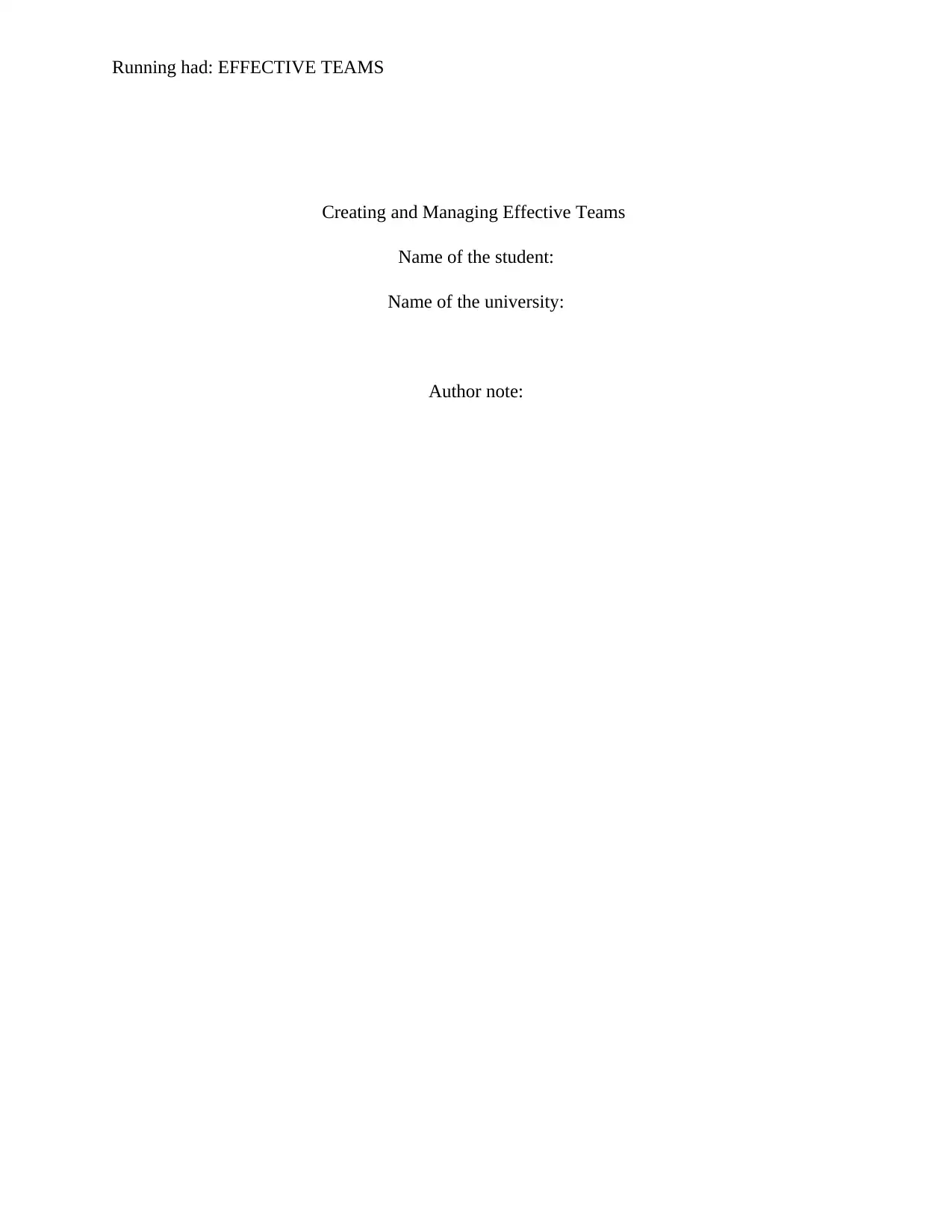
Running had: EFFECTIVE TEAMS
Creating and Managing Effective Teams
Name of the student:
Name of the university:
Author note:
Creating and Managing Effective Teams
Name of the student:
Name of the university:
Author note:
Paraphrase This Document
Need a fresh take? Get an instant paraphrase of this document with our AI Paraphraser
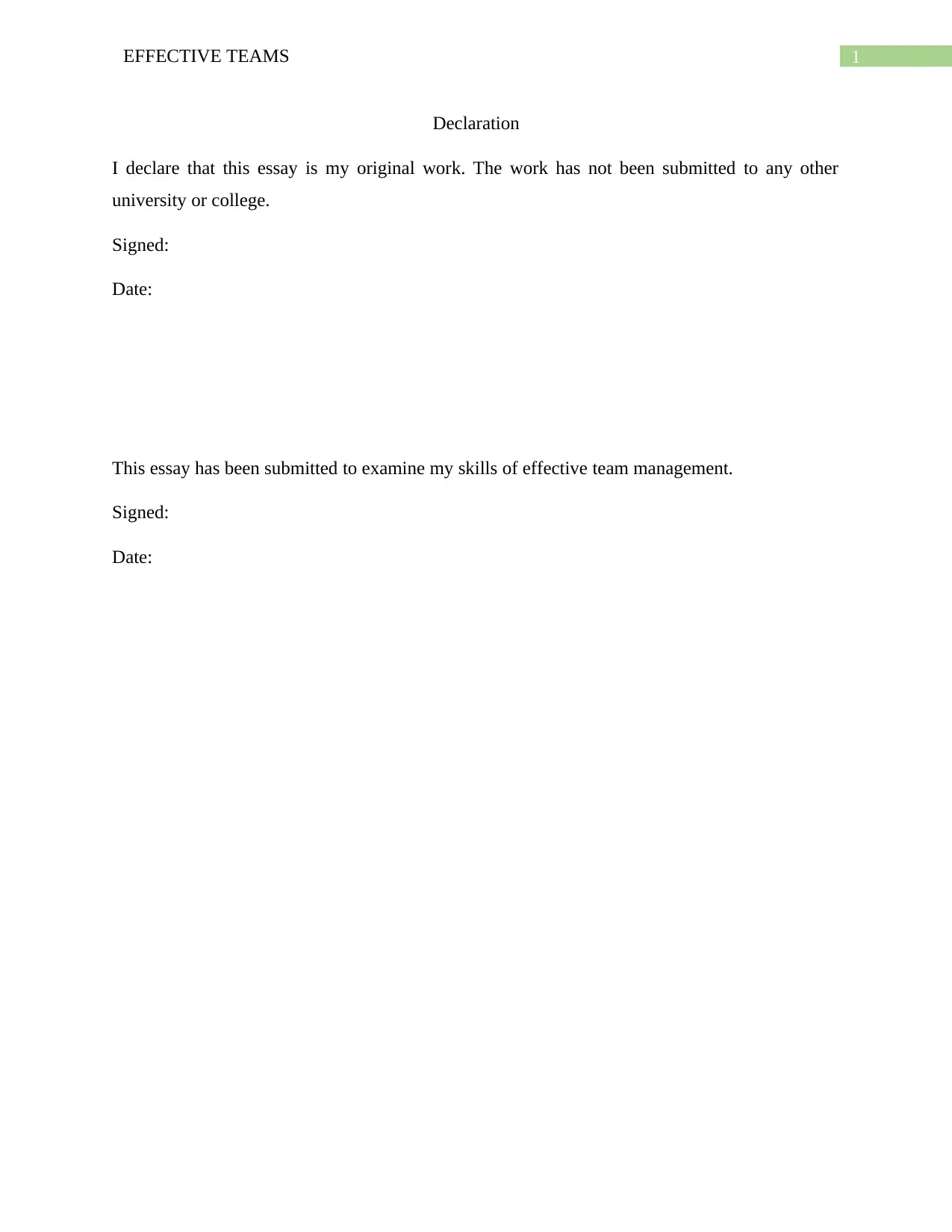
1EFFECTIVE TEAMS
Declaration
I declare that this essay is my original work. The work has not been submitted to any other
university or college.
Signed:
Date:
This essay has been submitted to examine my skills of effective team management.
Signed:
Date:
Declaration
I declare that this essay is my original work. The work has not been submitted to any other
university or college.
Signed:
Date:
This essay has been submitted to examine my skills of effective team management.
Signed:
Date:
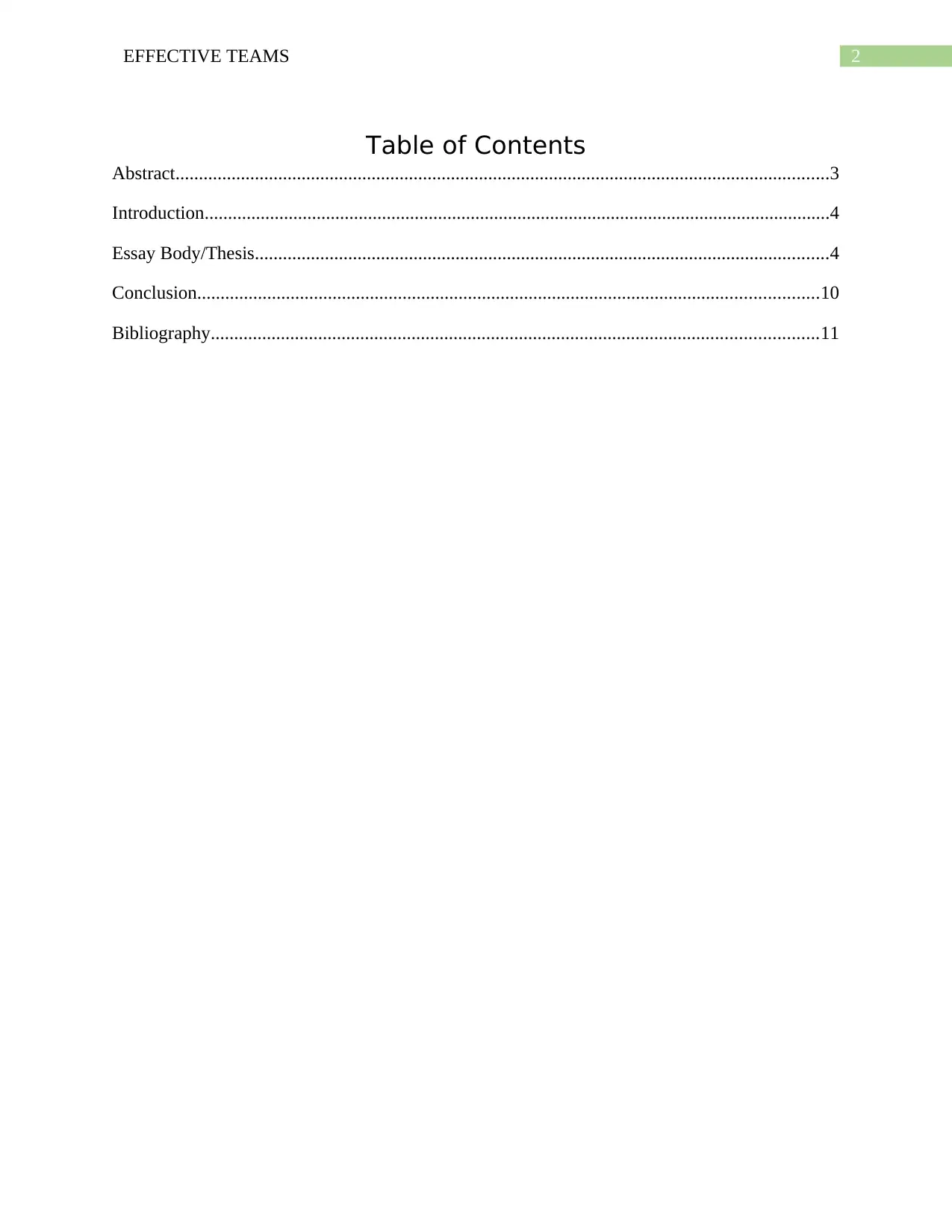
2EFFECTIVE TEAMS
Table of Contents
Abstract............................................................................................................................................3
Introduction......................................................................................................................................4
Essay Body/Thesis...........................................................................................................................4
Conclusion.....................................................................................................................................10
Bibliography..................................................................................................................................11
Table of Contents
Abstract............................................................................................................................................3
Introduction......................................................................................................................................4
Essay Body/Thesis...........................................................................................................................4
Conclusion.....................................................................................................................................10
Bibliography..................................................................................................................................11
⊘ This is a preview!⊘
Do you want full access?
Subscribe today to unlock all pages.

Trusted by 1+ million students worldwide
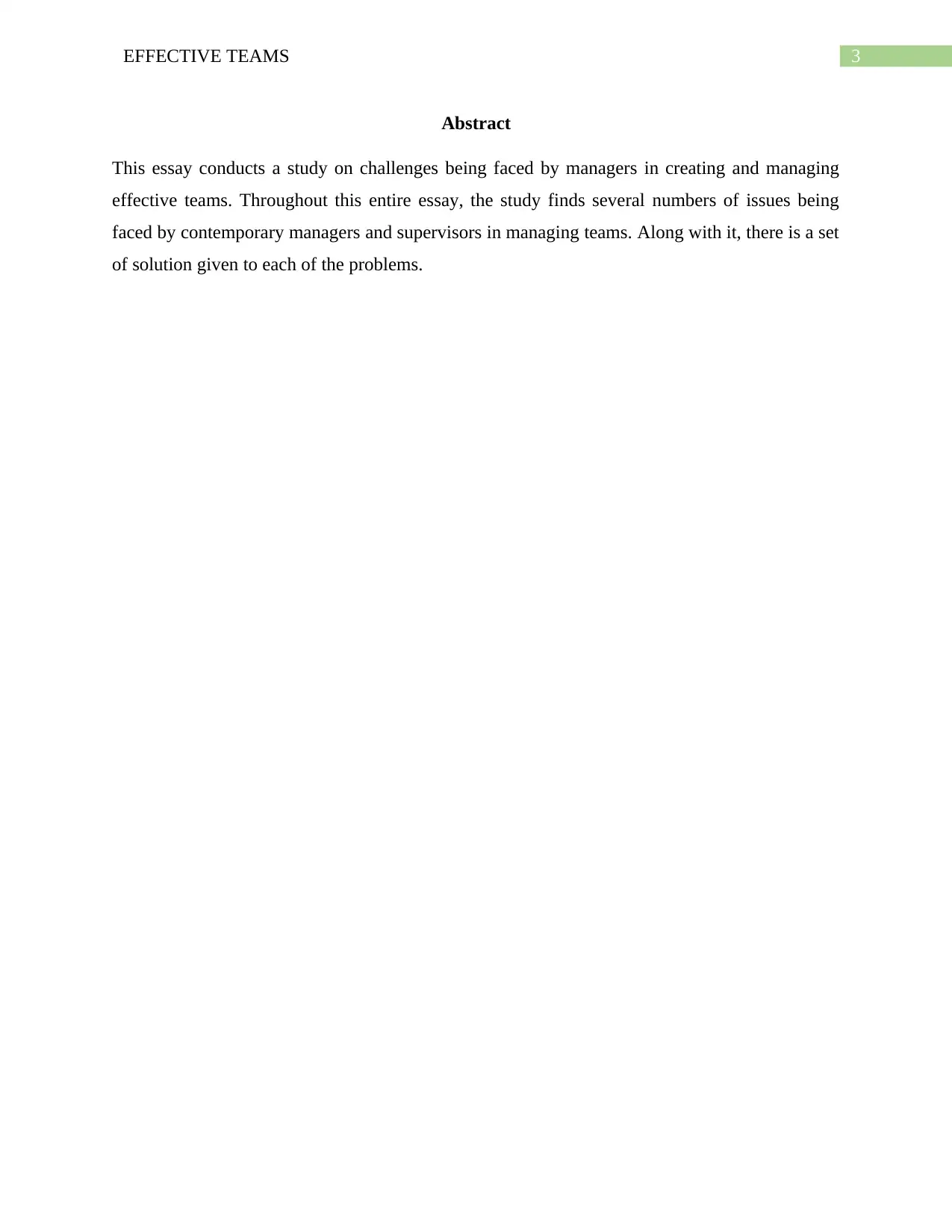
3EFFECTIVE TEAMS
Abstract
This essay conducts a study on challenges being faced by managers in creating and managing
effective teams. Throughout this entire essay, the study finds several numbers of issues being
faced by contemporary managers and supervisors in managing teams. Along with it, there is a set
of solution given to each of the problems.
Abstract
This essay conducts a study on challenges being faced by managers in creating and managing
effective teams. Throughout this entire essay, the study finds several numbers of issues being
faced by contemporary managers and supervisors in managing teams. Along with it, there is a set
of solution given to each of the problems.
Paraphrase This Document
Need a fresh take? Get an instant paraphrase of this document with our AI Paraphraser
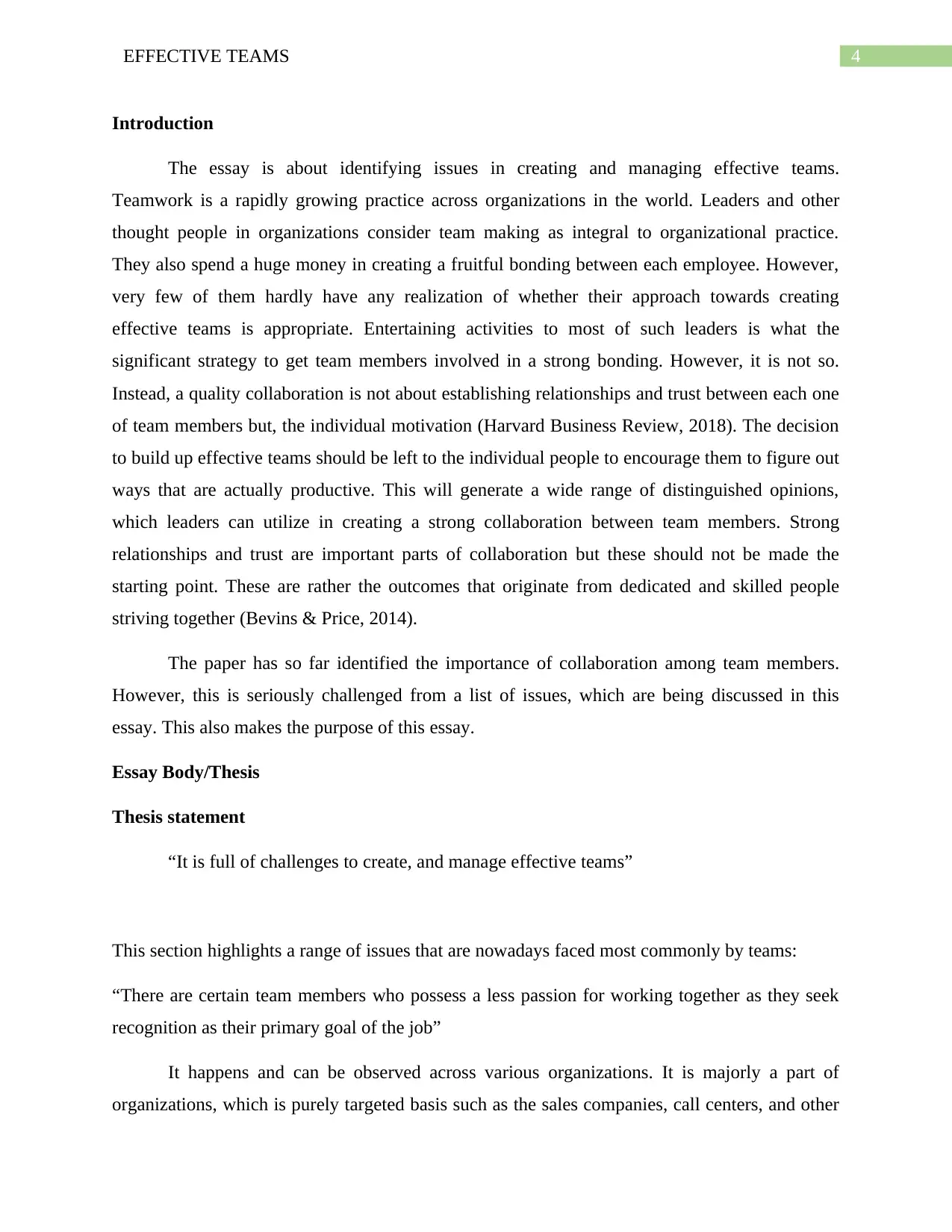
4EFFECTIVE TEAMS
Introduction
The essay is about identifying issues in creating and managing effective teams.
Teamwork is a rapidly growing practice across organizations in the world. Leaders and other
thought people in organizations consider team making as integral to organizational practice.
They also spend a huge money in creating a fruitful bonding between each employee. However,
very few of them hardly have any realization of whether their approach towards creating
effective teams is appropriate. Entertaining activities to most of such leaders is what the
significant strategy to get team members involved in a strong bonding. However, it is not so.
Instead, a quality collaboration is not about establishing relationships and trust between each one
of team members but, the individual motivation (Harvard Business Review, 2018). The decision
to build up effective teams should be left to the individual people to encourage them to figure out
ways that are actually productive. This will generate a wide range of distinguished opinions,
which leaders can utilize in creating a strong collaboration between team members. Strong
relationships and trust are important parts of collaboration but these should not be made the
starting point. These are rather the outcomes that originate from dedicated and skilled people
striving together (Bevins & Price, 2014).
The paper has so far identified the importance of collaboration among team members.
However, this is seriously challenged from a list of issues, which are being discussed in this
essay. This also makes the purpose of this essay.
Essay Body/Thesis
Thesis statement
“It is full of challenges to create, and manage effective teams”
This section highlights a range of issues that are nowadays faced most commonly by teams:
“There are certain team members who possess a less passion for working together as they seek
recognition as their primary goal of the job”
It happens and can be observed across various organizations. It is majorly a part of
organizations, which is purely targeted basis such as the sales companies, call centers, and other
Introduction
The essay is about identifying issues in creating and managing effective teams.
Teamwork is a rapidly growing practice across organizations in the world. Leaders and other
thought people in organizations consider team making as integral to organizational practice.
They also spend a huge money in creating a fruitful bonding between each employee. However,
very few of them hardly have any realization of whether their approach towards creating
effective teams is appropriate. Entertaining activities to most of such leaders is what the
significant strategy to get team members involved in a strong bonding. However, it is not so.
Instead, a quality collaboration is not about establishing relationships and trust between each one
of team members but, the individual motivation (Harvard Business Review, 2018). The decision
to build up effective teams should be left to the individual people to encourage them to figure out
ways that are actually productive. This will generate a wide range of distinguished opinions,
which leaders can utilize in creating a strong collaboration between team members. Strong
relationships and trust are important parts of collaboration but these should not be made the
starting point. These are rather the outcomes that originate from dedicated and skilled people
striving together (Bevins & Price, 2014).
The paper has so far identified the importance of collaboration among team members.
However, this is seriously challenged from a list of issues, which are being discussed in this
essay. This also makes the purpose of this essay.
Essay Body/Thesis
Thesis statement
“It is full of challenges to create, and manage effective teams”
This section highlights a range of issues that are nowadays faced most commonly by teams:
“There are certain team members who possess a less passion for working together as they seek
recognition as their primary goal of the job”
It happens and can be observed across various organizations. It is majorly a part of
organizations, which is purely targeted basis such as the sales companies, call centers, and other
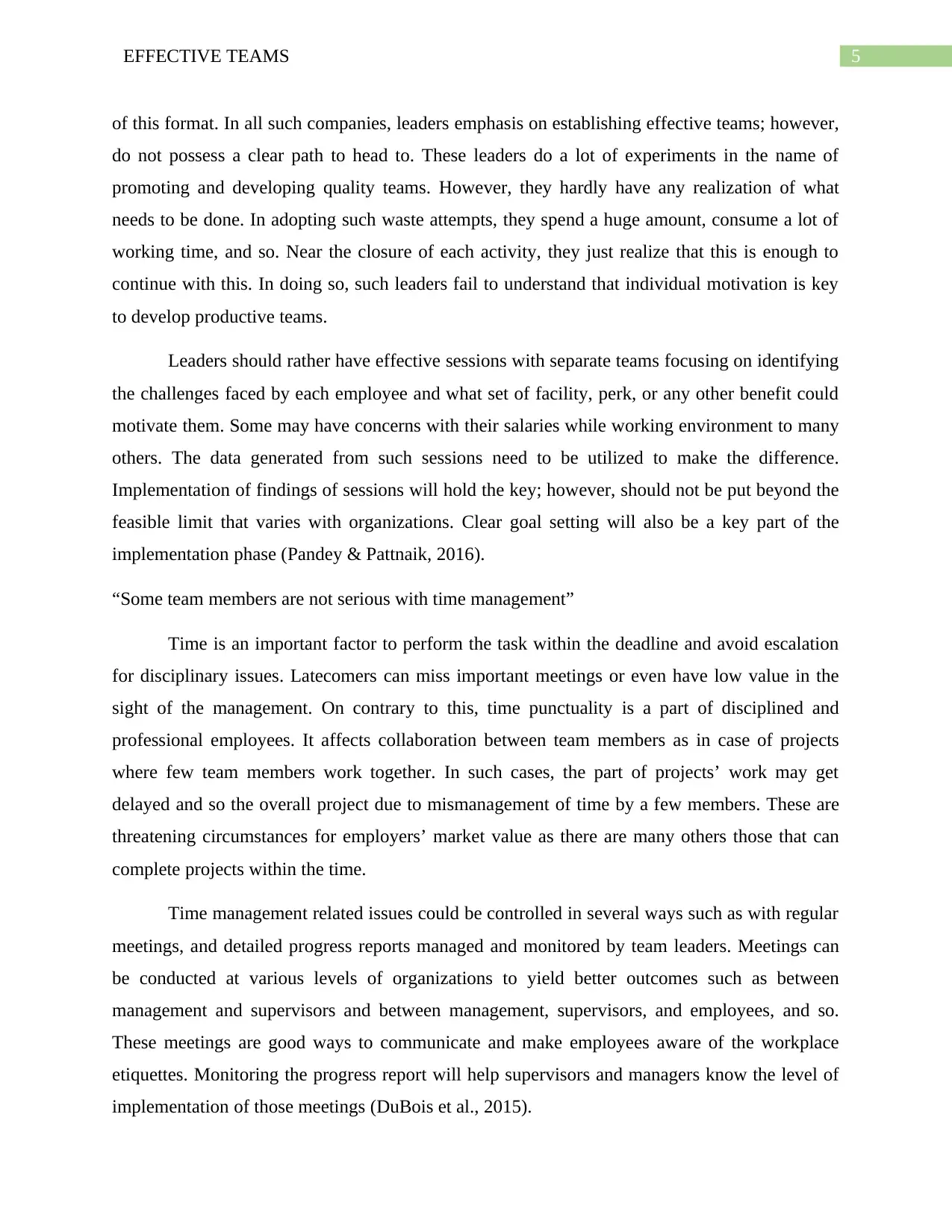
5EFFECTIVE TEAMS
of this format. In all such companies, leaders emphasis on establishing effective teams; however,
do not possess a clear path to head to. These leaders do a lot of experiments in the name of
promoting and developing quality teams. However, they hardly have any realization of what
needs to be done. In adopting such waste attempts, they spend a huge amount, consume a lot of
working time, and so. Near the closure of each activity, they just realize that this is enough to
continue with this. In doing so, such leaders fail to understand that individual motivation is key
to develop productive teams.
Leaders should rather have effective sessions with separate teams focusing on identifying
the challenges faced by each employee and what set of facility, perk, or any other benefit could
motivate them. Some may have concerns with their salaries while working environment to many
others. The data generated from such sessions need to be utilized to make the difference.
Implementation of findings of sessions will hold the key; however, should not be put beyond the
feasible limit that varies with organizations. Clear goal setting will also be a key part of the
implementation phase (Pandey & Pattnaik, 2016).
“Some team members are not serious with time management”
Time is an important factor to perform the task within the deadline and avoid escalation
for disciplinary issues. Latecomers can miss important meetings or even have low value in the
sight of the management. On contrary to this, time punctuality is a part of disciplined and
professional employees. It affects collaboration between team members as in case of projects
where few team members work together. In such cases, the part of projects’ work may get
delayed and so the overall project due to mismanagement of time by a few members. These are
threatening circumstances for employers’ market value as there are many others those that can
complete projects within the time.
Time management related issues could be controlled in several ways such as with regular
meetings, and detailed progress reports managed and monitored by team leaders. Meetings can
be conducted at various levels of organizations to yield better outcomes such as between
management and supervisors and between management, supervisors, and employees, and so.
These meetings are good ways to communicate and make employees aware of the workplace
etiquettes. Monitoring the progress report will help supervisors and managers know the level of
implementation of those meetings (DuBois et al., 2015).
of this format. In all such companies, leaders emphasis on establishing effective teams; however,
do not possess a clear path to head to. These leaders do a lot of experiments in the name of
promoting and developing quality teams. However, they hardly have any realization of what
needs to be done. In adopting such waste attempts, they spend a huge amount, consume a lot of
working time, and so. Near the closure of each activity, they just realize that this is enough to
continue with this. In doing so, such leaders fail to understand that individual motivation is key
to develop productive teams.
Leaders should rather have effective sessions with separate teams focusing on identifying
the challenges faced by each employee and what set of facility, perk, or any other benefit could
motivate them. Some may have concerns with their salaries while working environment to many
others. The data generated from such sessions need to be utilized to make the difference.
Implementation of findings of sessions will hold the key; however, should not be put beyond the
feasible limit that varies with organizations. Clear goal setting will also be a key part of the
implementation phase (Pandey & Pattnaik, 2016).
“Some team members are not serious with time management”
Time is an important factor to perform the task within the deadline and avoid escalation
for disciplinary issues. Latecomers can miss important meetings or even have low value in the
sight of the management. On contrary to this, time punctuality is a part of disciplined and
professional employees. It affects collaboration between team members as in case of projects
where few team members work together. In such cases, the part of projects’ work may get
delayed and so the overall project due to mismanagement of time by a few members. These are
threatening circumstances for employers’ market value as there are many others those that can
complete projects within the time.
Time management related issues could be controlled in several ways such as with regular
meetings, and detailed progress reports managed and monitored by team leaders. Meetings can
be conducted at various levels of organizations to yield better outcomes such as between
management and supervisors and between management, supervisors, and employees, and so.
These meetings are good ways to communicate and make employees aware of the workplace
etiquettes. Monitoring the progress report will help supervisors and managers know the level of
implementation of those meetings (DuBois et al., 2015).
⊘ This is a preview!⊘
Do you want full access?
Subscribe today to unlock all pages.

Trusted by 1+ million students worldwide
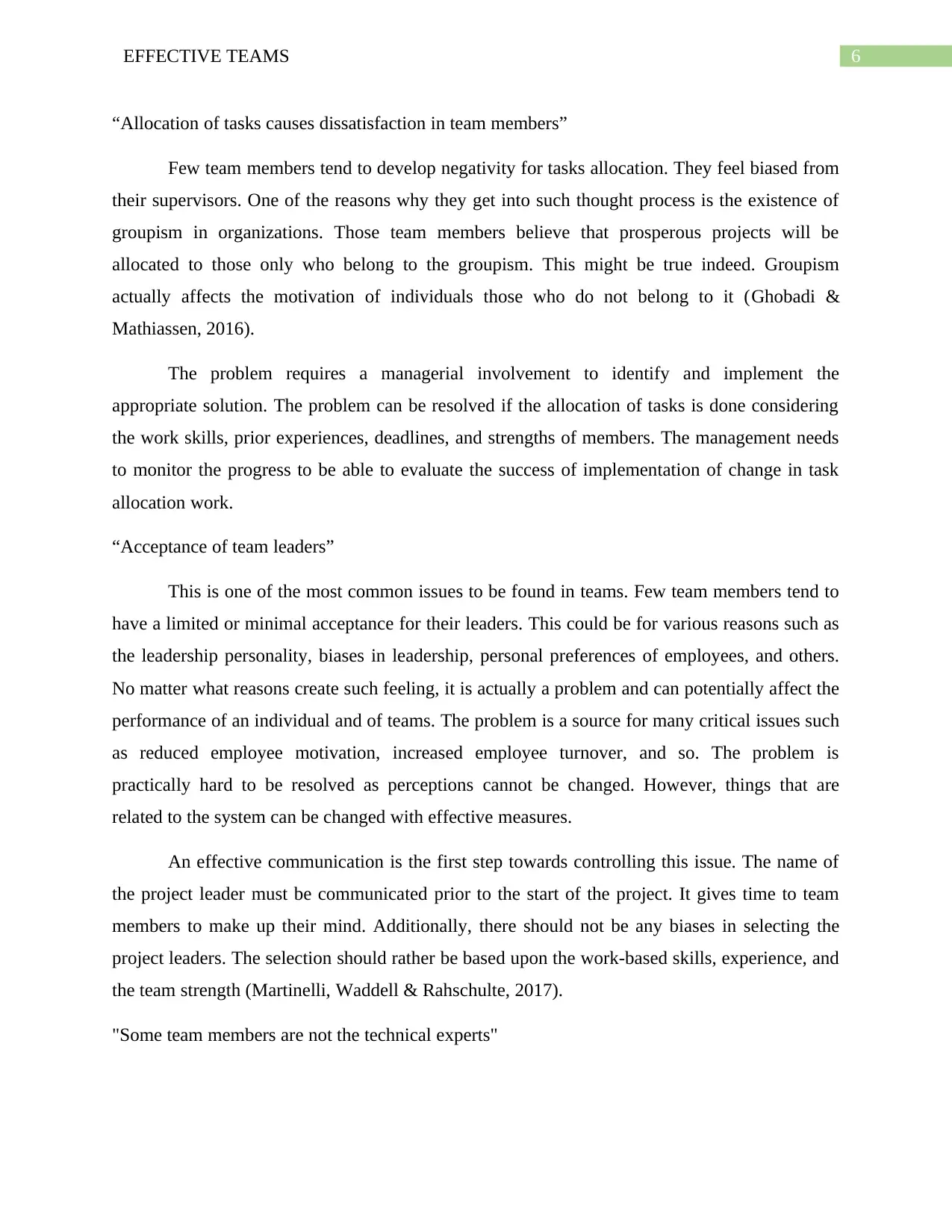
6EFFECTIVE TEAMS
“Allocation of tasks causes dissatisfaction in team members”
Few team members tend to develop negativity for tasks allocation. They feel biased from
their supervisors. One of the reasons why they get into such thought process is the existence of
groupism in organizations. Those team members believe that prosperous projects will be
allocated to those only who belong to the groupism. This might be true indeed. Groupism
actually affects the motivation of individuals those who do not belong to it (Ghobadi &
Mathiassen, 2016).
The problem requires a managerial involvement to identify and implement the
appropriate solution. The problem can be resolved if the allocation of tasks is done considering
the work skills, prior experiences, deadlines, and strengths of members. The management needs
to monitor the progress to be able to evaluate the success of implementation of change in task
allocation work.
“Acceptance of team leaders”
This is one of the most common issues to be found in teams. Few team members tend to
have a limited or minimal acceptance for their leaders. This could be for various reasons such as
the leadership personality, biases in leadership, personal preferences of employees, and others.
No matter what reasons create such feeling, it is actually a problem and can potentially affect the
performance of an individual and of teams. The problem is a source for many critical issues such
as reduced employee motivation, increased employee turnover, and so. The problem is
practically hard to be resolved as perceptions cannot be changed. However, things that are
related to the system can be changed with effective measures.
An effective communication is the first step towards controlling this issue. The name of
the project leader must be communicated prior to the start of the project. It gives time to team
members to make up their mind. Additionally, there should not be any biases in selecting the
project leaders. The selection should rather be based upon the work-based skills, experience, and
the team strength (Martinelli, Waddell & Rahschulte, 2017).
"Some team members are not the technical experts"
“Allocation of tasks causes dissatisfaction in team members”
Few team members tend to develop negativity for tasks allocation. They feel biased from
their supervisors. One of the reasons why they get into such thought process is the existence of
groupism in organizations. Those team members believe that prosperous projects will be
allocated to those only who belong to the groupism. This might be true indeed. Groupism
actually affects the motivation of individuals those who do not belong to it (Ghobadi &
Mathiassen, 2016).
The problem requires a managerial involvement to identify and implement the
appropriate solution. The problem can be resolved if the allocation of tasks is done considering
the work skills, prior experiences, deadlines, and strengths of members. The management needs
to monitor the progress to be able to evaluate the success of implementation of change in task
allocation work.
“Acceptance of team leaders”
This is one of the most common issues to be found in teams. Few team members tend to
have a limited or minimal acceptance for their leaders. This could be for various reasons such as
the leadership personality, biases in leadership, personal preferences of employees, and others.
No matter what reasons create such feeling, it is actually a problem and can potentially affect the
performance of an individual and of teams. The problem is a source for many critical issues such
as reduced employee motivation, increased employee turnover, and so. The problem is
practically hard to be resolved as perceptions cannot be changed. However, things that are
related to the system can be changed with effective measures.
An effective communication is the first step towards controlling this issue. The name of
the project leader must be communicated prior to the start of the project. It gives time to team
members to make up their mind. Additionally, there should not be any biases in selecting the
project leaders. The selection should rather be based upon the work-based skills, experience, and
the team strength (Martinelli, Waddell & Rahschulte, 2017).
"Some team members are not the technical experts"
Paraphrase This Document
Need a fresh take? Get an instant paraphrase of this document with our AI Paraphraser
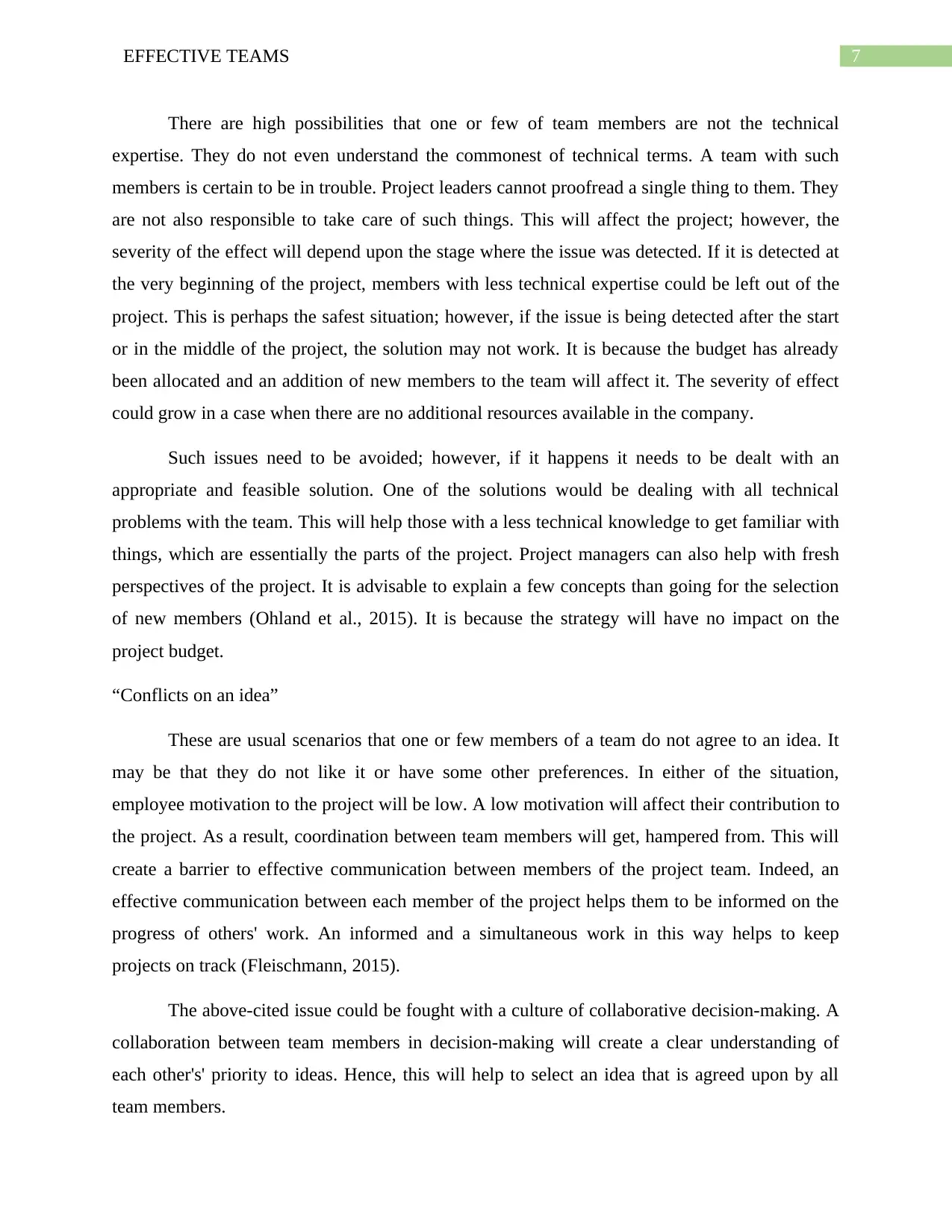
7EFFECTIVE TEAMS
There are high possibilities that one or few of team members are not the technical
expertise. They do not even understand the commonest of technical terms. A team with such
members is certain to be in trouble. Project leaders cannot proofread a single thing to them. They
are not also responsible to take care of such things. This will affect the project; however, the
severity of the effect will depend upon the stage where the issue was detected. If it is detected at
the very beginning of the project, members with less technical expertise could be left out of the
project. This is perhaps the safest situation; however, if the issue is being detected after the start
or in the middle of the project, the solution may not work. It is because the budget has already
been allocated and an addition of new members to the team will affect it. The severity of effect
could grow in a case when there are no additional resources available in the company.
Such issues need to be avoided; however, if it happens it needs to be dealt with an
appropriate and feasible solution. One of the solutions would be dealing with all technical
problems with the team. This will help those with a less technical knowledge to get familiar with
things, which are essentially the parts of the project. Project managers can also help with fresh
perspectives of the project. It is advisable to explain a few concepts than going for the selection
of new members (Ohland et al., 2015). It is because the strategy will have no impact on the
project budget.
“Conflicts on an idea”
These are usual scenarios that one or few members of a team do not agree to an idea. It
may be that they do not like it or have some other preferences. In either of the situation,
employee motivation to the project will be low. A low motivation will affect their contribution to
the project. As a result, coordination between team members will get, hampered from. This will
create a barrier to effective communication between members of the project team. Indeed, an
effective communication between each member of the project helps them to be informed on the
progress of others' work. An informed and a simultaneous work in this way helps to keep
projects on track (Fleischmann, 2015).
The above-cited issue could be fought with a culture of collaborative decision-making. A
collaboration between team members in decision-making will create a clear understanding of
each other's' priority to ideas. Hence, this will help to select an idea that is agreed upon by all
team members.
There are high possibilities that one or few of team members are not the technical
expertise. They do not even understand the commonest of technical terms. A team with such
members is certain to be in trouble. Project leaders cannot proofread a single thing to them. They
are not also responsible to take care of such things. This will affect the project; however, the
severity of the effect will depend upon the stage where the issue was detected. If it is detected at
the very beginning of the project, members with less technical expertise could be left out of the
project. This is perhaps the safest situation; however, if the issue is being detected after the start
or in the middle of the project, the solution may not work. It is because the budget has already
been allocated and an addition of new members to the team will affect it. The severity of effect
could grow in a case when there are no additional resources available in the company.
Such issues need to be avoided; however, if it happens it needs to be dealt with an
appropriate and feasible solution. One of the solutions would be dealing with all technical
problems with the team. This will help those with a less technical knowledge to get familiar with
things, which are essentially the parts of the project. Project managers can also help with fresh
perspectives of the project. It is advisable to explain a few concepts than going for the selection
of new members (Ohland et al., 2015). It is because the strategy will have no impact on the
project budget.
“Conflicts on an idea”
These are usual scenarios that one or few members of a team do not agree to an idea. It
may be that they do not like it or have some other preferences. In either of the situation,
employee motivation to the project will be low. A low motivation will affect their contribution to
the project. As a result, coordination between team members will get, hampered from. This will
create a barrier to effective communication between members of the project team. Indeed, an
effective communication between each member of the project helps them to be informed on the
progress of others' work. An informed and a simultaneous work in this way helps to keep
projects on track (Fleischmann, 2015).
The above-cited issue could be fought with a culture of collaborative decision-making. A
collaboration between team members in decision-making will create a clear understanding of
each other's' priority to ideas. Hence, this will help to select an idea that is agreed upon by all
team members.
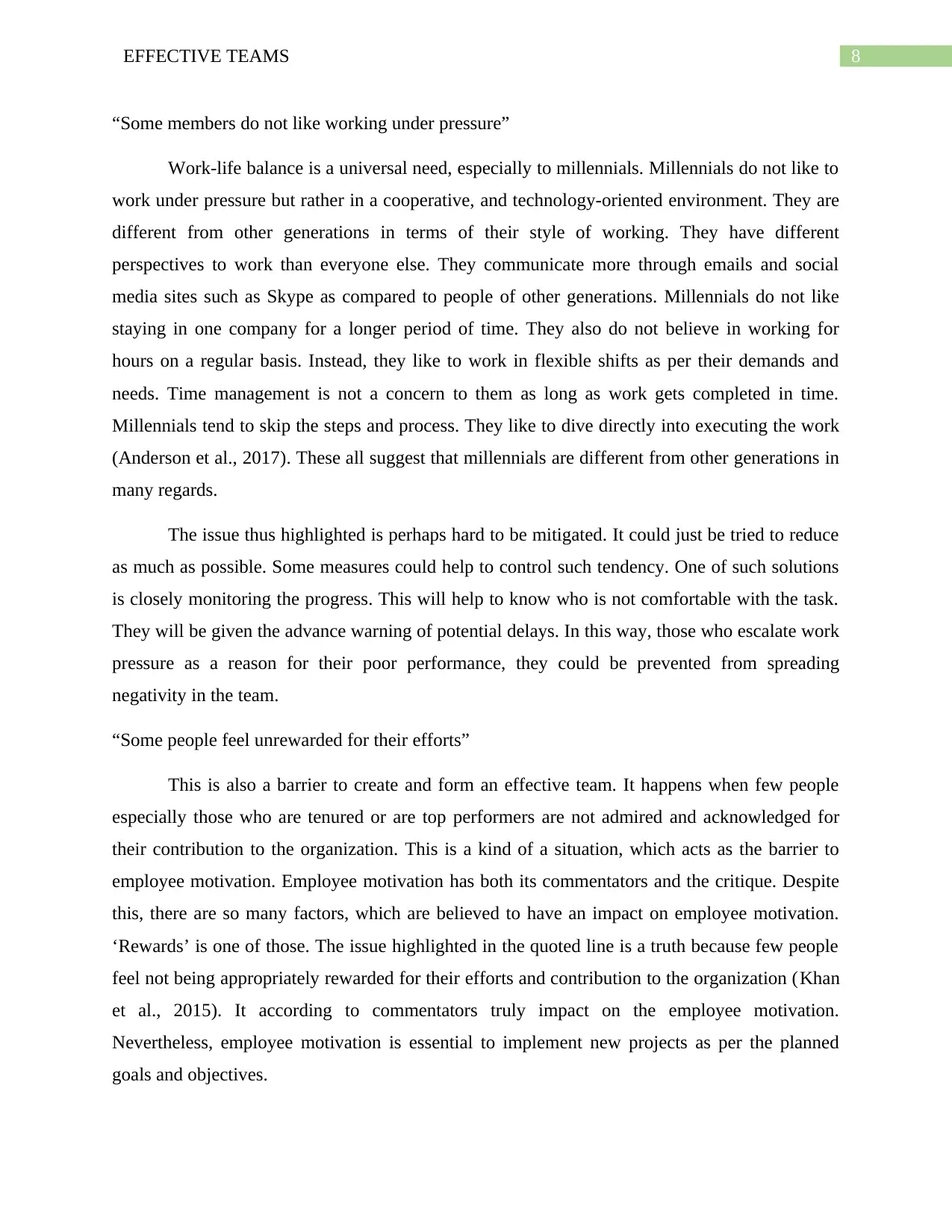
8EFFECTIVE TEAMS
“Some members do not like working under pressure”
Work-life balance is a universal need, especially to millennials. Millennials do not like to
work under pressure but rather in a cooperative, and technology-oriented environment. They are
different from other generations in terms of their style of working. They have different
perspectives to work than everyone else. They communicate more through emails and social
media sites such as Skype as compared to people of other generations. Millennials do not like
staying in one company for a longer period of time. They also do not believe in working for
hours on a regular basis. Instead, they like to work in flexible shifts as per their demands and
needs. Time management is not a concern to them as long as work gets completed in time.
Millennials tend to skip the steps and process. They like to dive directly into executing the work
(Anderson et al., 2017). These all suggest that millennials are different from other generations in
many regards.
The issue thus highlighted is perhaps hard to be mitigated. It could just be tried to reduce
as much as possible. Some measures could help to control such tendency. One of such solutions
is closely monitoring the progress. This will help to know who is not comfortable with the task.
They will be given the advance warning of potential delays. In this way, those who escalate work
pressure as a reason for their poor performance, they could be prevented from spreading
negativity in the team.
“Some people feel unrewarded for their efforts”
This is also a barrier to create and form an effective team. It happens when few people
especially those who are tenured or are top performers are not admired and acknowledged for
their contribution to the organization. This is a kind of a situation, which acts as the barrier to
employee motivation. Employee motivation has both its commentators and the critique. Despite
this, there are so many factors, which are believed to have an impact on employee motivation.
‘Rewards’ is one of those. The issue highlighted in the quoted line is a truth because few people
feel not being appropriately rewarded for their efforts and contribution to the organization (Khan
et al., 2015). It according to commentators truly impact on the employee motivation.
Nevertheless, employee motivation is essential to implement new projects as per the planned
goals and objectives.
“Some members do not like working under pressure”
Work-life balance is a universal need, especially to millennials. Millennials do not like to
work under pressure but rather in a cooperative, and technology-oriented environment. They are
different from other generations in terms of their style of working. They have different
perspectives to work than everyone else. They communicate more through emails and social
media sites such as Skype as compared to people of other generations. Millennials do not like
staying in one company for a longer period of time. They also do not believe in working for
hours on a regular basis. Instead, they like to work in flexible shifts as per their demands and
needs. Time management is not a concern to them as long as work gets completed in time.
Millennials tend to skip the steps and process. They like to dive directly into executing the work
(Anderson et al., 2017). These all suggest that millennials are different from other generations in
many regards.
The issue thus highlighted is perhaps hard to be mitigated. It could just be tried to reduce
as much as possible. Some measures could help to control such tendency. One of such solutions
is closely monitoring the progress. This will help to know who is not comfortable with the task.
They will be given the advance warning of potential delays. In this way, those who escalate work
pressure as a reason for their poor performance, they could be prevented from spreading
negativity in the team.
“Some people feel unrewarded for their efforts”
This is also a barrier to create and form an effective team. It happens when few people
especially those who are tenured or are top performers are not admired and acknowledged for
their contribution to the organization. This is a kind of a situation, which acts as the barrier to
employee motivation. Employee motivation has both its commentators and the critique. Despite
this, there are so many factors, which are believed to have an impact on employee motivation.
‘Rewards’ is one of those. The issue highlighted in the quoted line is a truth because few people
feel not being appropriately rewarded for their efforts and contribution to the organization (Khan
et al., 2015). It according to commentators truly impact on the employee motivation.
Nevertheless, employee motivation is essential to implement new projects as per the planned
goals and objectives.
⊘ This is a preview!⊘
Do you want full access?
Subscribe today to unlock all pages.

Trusted by 1+ million students worldwide
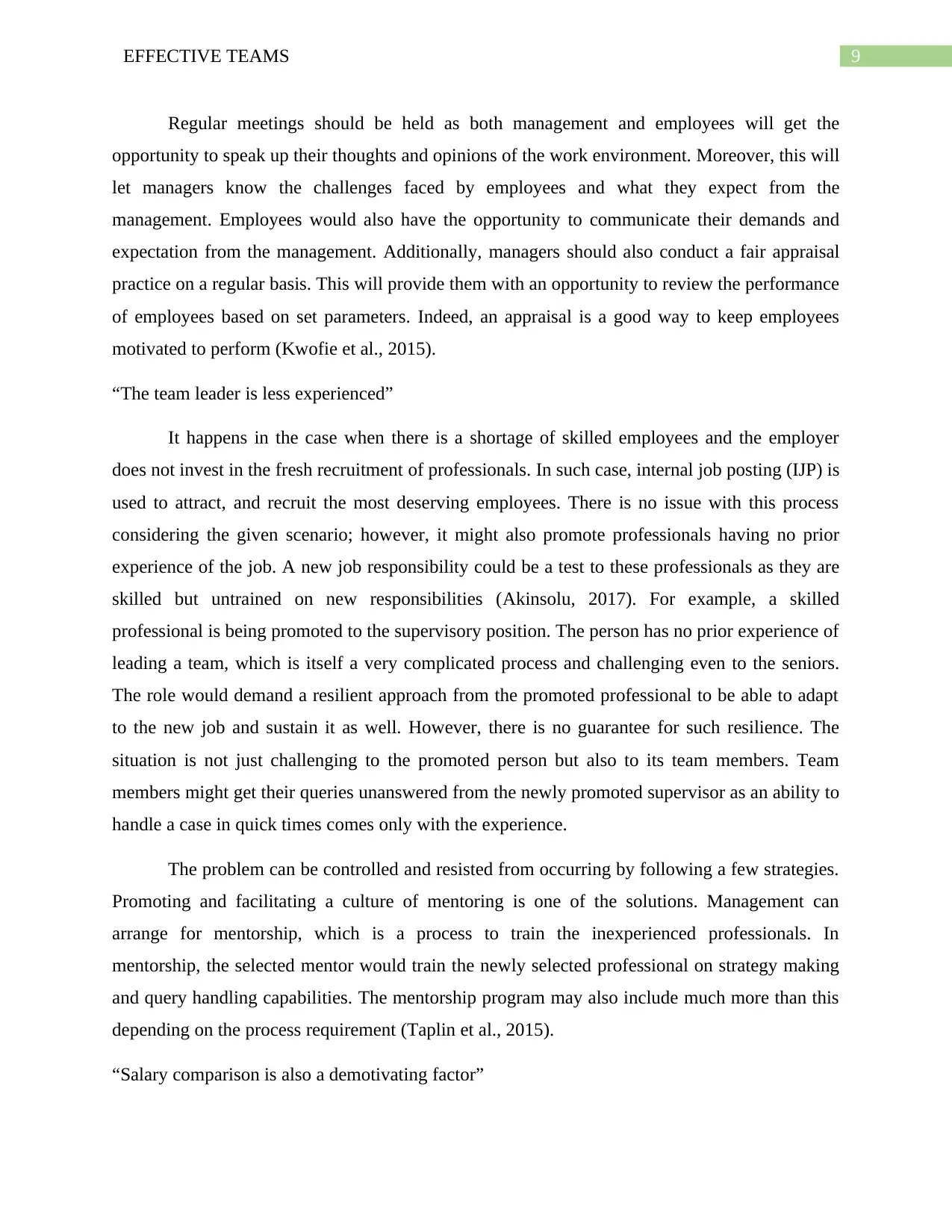
9EFFECTIVE TEAMS
Regular meetings should be held as both management and employees will get the
opportunity to speak up their thoughts and opinions of the work environment. Moreover, this will
let managers know the challenges faced by employees and what they expect from the
management. Employees would also have the opportunity to communicate their demands and
expectation from the management. Additionally, managers should also conduct a fair appraisal
practice on a regular basis. This will provide them with an opportunity to review the performance
of employees based on set parameters. Indeed, an appraisal is a good way to keep employees
motivated to perform (Kwofie et al., 2015).
“The team leader is less experienced”
It happens in the case when there is a shortage of skilled employees and the employer
does not invest in the fresh recruitment of professionals. In such case, internal job posting (IJP) is
used to attract, and recruit the most deserving employees. There is no issue with this process
considering the given scenario; however, it might also promote professionals having no prior
experience of the job. A new job responsibility could be a test to these professionals as they are
skilled but untrained on new responsibilities (Akinsolu, 2017). For example, a skilled
professional is being promoted to the supervisory position. The person has no prior experience of
leading a team, which is itself a very complicated process and challenging even to the seniors.
The role would demand a resilient approach from the promoted professional to be able to adapt
to the new job and sustain it as well. However, there is no guarantee for such resilience. The
situation is not just challenging to the promoted person but also to its team members. Team
members might get their queries unanswered from the newly promoted supervisor as an ability to
handle a case in quick times comes only with the experience.
The problem can be controlled and resisted from occurring by following a few strategies.
Promoting and facilitating a culture of mentoring is one of the solutions. Management can
arrange for mentorship, which is a process to train the inexperienced professionals. In
mentorship, the selected mentor would train the newly selected professional on strategy making
and query handling capabilities. The mentorship program may also include much more than this
depending on the process requirement (Taplin et al., 2015).
“Salary comparison is also a demotivating factor”
Regular meetings should be held as both management and employees will get the
opportunity to speak up their thoughts and opinions of the work environment. Moreover, this will
let managers know the challenges faced by employees and what they expect from the
management. Employees would also have the opportunity to communicate their demands and
expectation from the management. Additionally, managers should also conduct a fair appraisal
practice on a regular basis. This will provide them with an opportunity to review the performance
of employees based on set parameters. Indeed, an appraisal is a good way to keep employees
motivated to perform (Kwofie et al., 2015).
“The team leader is less experienced”
It happens in the case when there is a shortage of skilled employees and the employer
does not invest in the fresh recruitment of professionals. In such case, internal job posting (IJP) is
used to attract, and recruit the most deserving employees. There is no issue with this process
considering the given scenario; however, it might also promote professionals having no prior
experience of the job. A new job responsibility could be a test to these professionals as they are
skilled but untrained on new responsibilities (Akinsolu, 2017). For example, a skilled
professional is being promoted to the supervisory position. The person has no prior experience of
leading a team, which is itself a very complicated process and challenging even to the seniors.
The role would demand a resilient approach from the promoted professional to be able to adapt
to the new job and sustain it as well. However, there is no guarantee for such resilience. The
situation is not just challenging to the promoted person but also to its team members. Team
members might get their queries unanswered from the newly promoted supervisor as an ability to
handle a case in quick times comes only with the experience.
The problem can be controlled and resisted from occurring by following a few strategies.
Promoting and facilitating a culture of mentoring is one of the solutions. Management can
arrange for mentorship, which is a process to train the inexperienced professionals. In
mentorship, the selected mentor would train the newly selected professional on strategy making
and query handling capabilities. The mentorship program may also include much more than this
depending on the process requirement (Taplin et al., 2015).
“Salary comparison is also a demotivating factor”
Paraphrase This Document
Need a fresh take? Get an instant paraphrase of this document with our AI Paraphraser
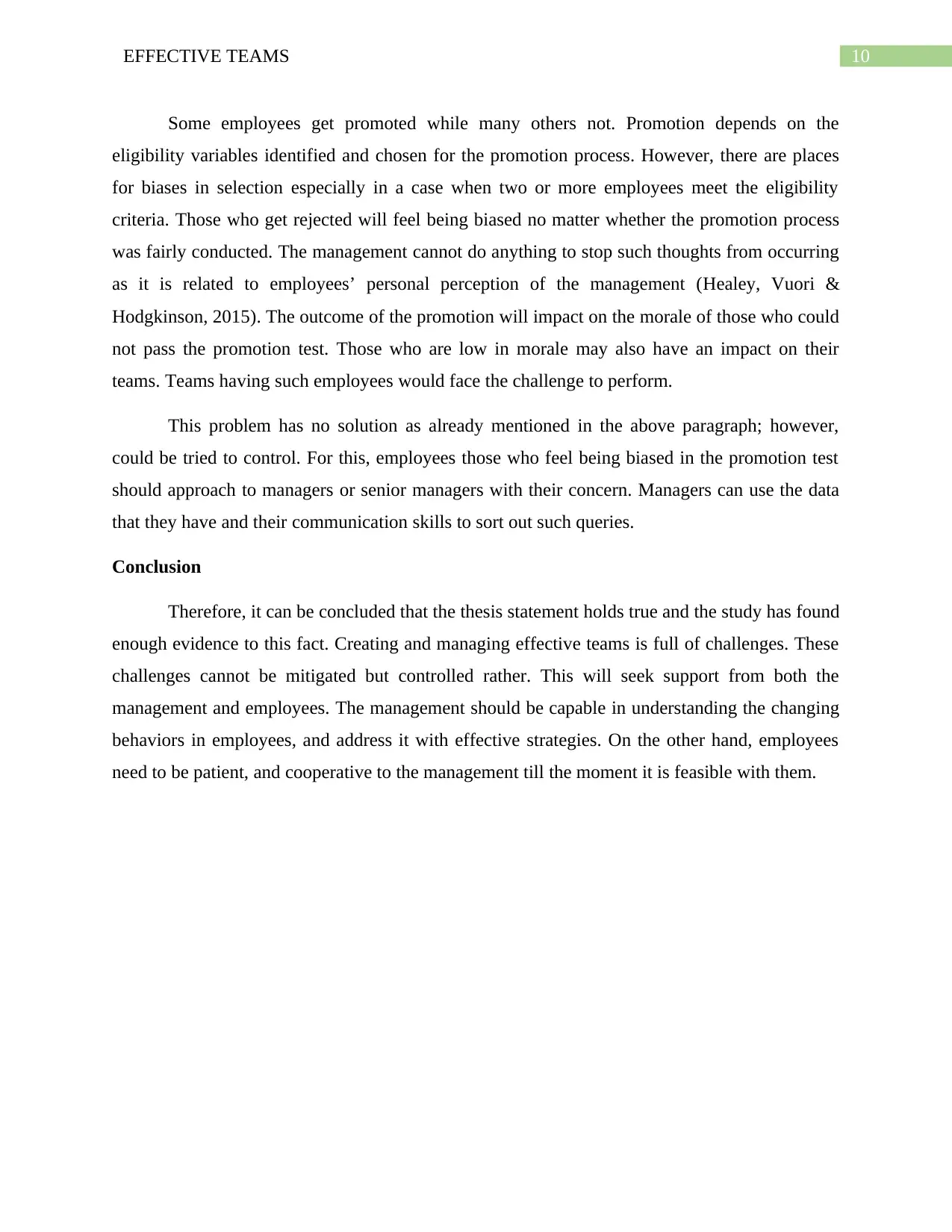
10EFFECTIVE TEAMS
Some employees get promoted while many others not. Promotion depends on the
eligibility variables identified and chosen for the promotion process. However, there are places
for biases in selection especially in a case when two or more employees meet the eligibility
criteria. Those who get rejected will feel being biased no matter whether the promotion process
was fairly conducted. The management cannot do anything to stop such thoughts from occurring
as it is related to employees’ personal perception of the management (Healey, Vuori &
Hodgkinson, 2015). The outcome of the promotion will impact on the morale of those who could
not pass the promotion test. Those who are low in morale may also have an impact on their
teams. Teams having such employees would face the challenge to perform.
This problem has no solution as already mentioned in the above paragraph; however,
could be tried to control. For this, employees those who feel being biased in the promotion test
should approach to managers or senior managers with their concern. Managers can use the data
that they have and their communication skills to sort out such queries.
Conclusion
Therefore, it can be concluded that the thesis statement holds true and the study has found
enough evidence to this fact. Creating and managing effective teams is full of challenges. These
challenges cannot be mitigated but controlled rather. This will seek support from both the
management and employees. The management should be capable in understanding the changing
behaviors in employees, and address it with effective strategies. On the other hand, employees
need to be patient, and cooperative to the management till the moment it is feasible with them.
Some employees get promoted while many others not. Promotion depends on the
eligibility variables identified and chosen for the promotion process. However, there are places
for biases in selection especially in a case when two or more employees meet the eligibility
criteria. Those who get rejected will feel being biased no matter whether the promotion process
was fairly conducted. The management cannot do anything to stop such thoughts from occurring
as it is related to employees’ personal perception of the management (Healey, Vuori &
Hodgkinson, 2015). The outcome of the promotion will impact on the morale of those who could
not pass the promotion test. Those who are low in morale may also have an impact on their
teams. Teams having such employees would face the challenge to perform.
This problem has no solution as already mentioned in the above paragraph; however,
could be tried to control. For this, employees those who feel being biased in the promotion test
should approach to managers or senior managers with their concern. Managers can use the data
that they have and their communication skills to sort out such queries.
Conclusion
Therefore, it can be concluded that the thesis statement holds true and the study has found
enough evidence to this fact. Creating and managing effective teams is full of challenges. These
challenges cannot be mitigated but controlled rather. This will seek support from both the
management and employees. The management should be capable in understanding the changing
behaviors in employees, and address it with effective strategies. On the other hand, employees
need to be patient, and cooperative to the management till the moment it is feasible with them.
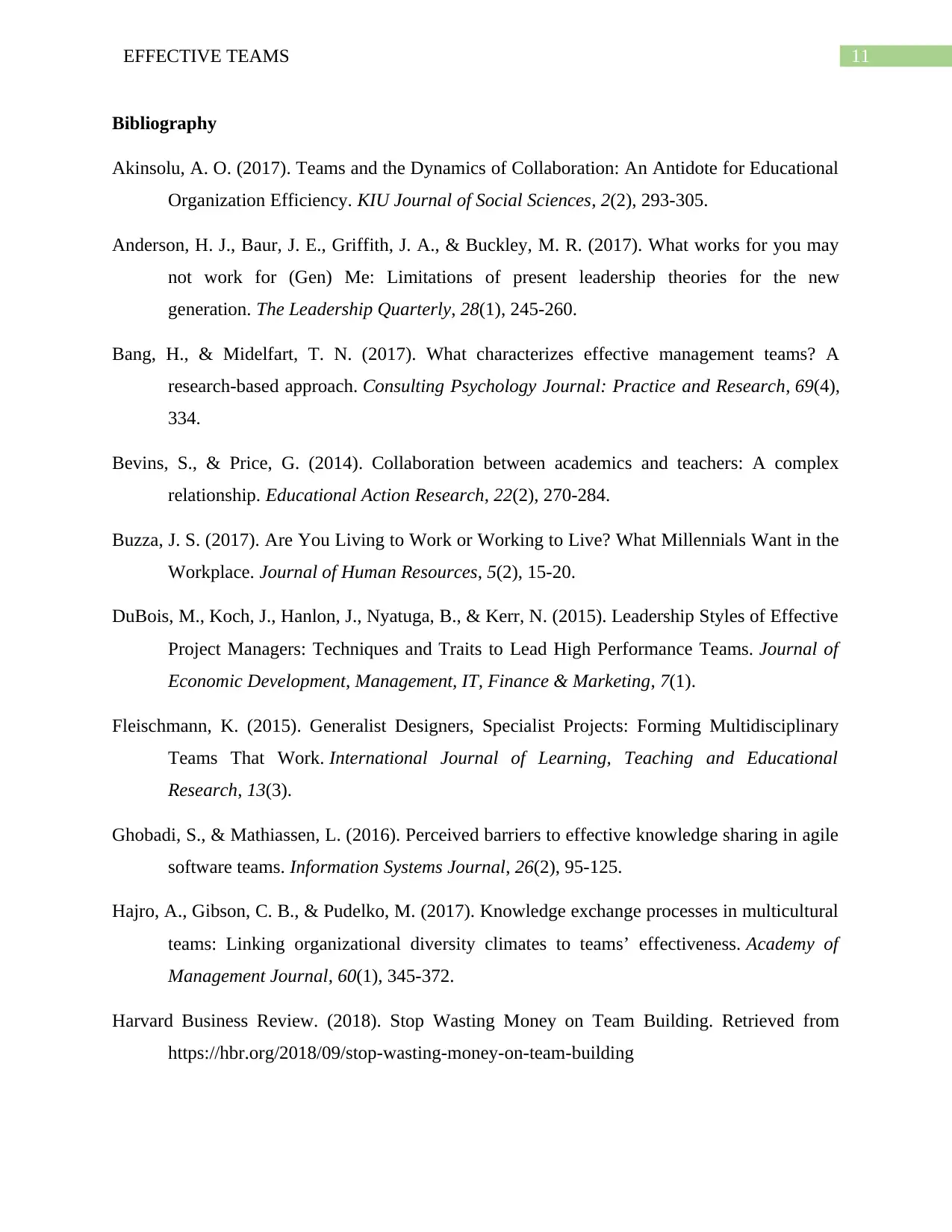
11EFFECTIVE TEAMS
Bibliography
Akinsolu, A. O. (2017). Teams and the Dynamics of Collaboration: An Antidote for Educational
Organization Efficiency. KIU Journal of Social Sciences, 2(2), 293-305.
Anderson, H. J., Baur, J. E., Griffith, J. A., & Buckley, M. R. (2017). What works for you may
not work for (Gen) Me: Limitations of present leadership theories for the new
generation. The Leadership Quarterly, 28(1), 245-260.
Bang, H., & Midelfart, T. N. (2017). What characterizes effective management teams? A
research-based approach. Consulting Psychology Journal: Practice and Research, 69(4),
334.
Bevins, S., & Price, G. (2014). Collaboration between academics and teachers: A complex
relationship. Educational Action Research, 22(2), 270-284.
Buzza, J. S. (2017). Are You Living to Work or Working to Live? What Millennials Want in the
Workplace. Journal of Human Resources, 5(2), 15-20.
DuBois, M., Koch, J., Hanlon, J., Nyatuga, B., & Kerr, N. (2015). Leadership Styles of Effective
Project Managers: Techniques and Traits to Lead High Performance Teams. Journal of
Economic Development, Management, IT, Finance & Marketing, 7(1).
Fleischmann, K. (2015). Generalist Designers, Specialist Projects: Forming Multidisciplinary
Teams That Work. International Journal of Learning, Teaching and Educational
Research, 13(3).
Ghobadi, S., & Mathiassen, L. (2016). Perceived barriers to effective knowledge sharing in agile
software teams. Information Systems Journal, 26(2), 95-125.
Hajro, A., Gibson, C. B., & Pudelko, M. (2017). Knowledge exchange processes in multicultural
teams: Linking organizational diversity climates to teams’ effectiveness. Academy of
Management Journal, 60(1), 345-372.
Harvard Business Review. (2018). Stop Wasting Money on Team Building. Retrieved from
https://hbr.org/2018/09/stop-wasting-money-on-team-building
Bibliography
Akinsolu, A. O. (2017). Teams and the Dynamics of Collaboration: An Antidote for Educational
Organization Efficiency. KIU Journal of Social Sciences, 2(2), 293-305.
Anderson, H. J., Baur, J. E., Griffith, J. A., & Buckley, M. R. (2017). What works for you may
not work for (Gen) Me: Limitations of present leadership theories for the new
generation. The Leadership Quarterly, 28(1), 245-260.
Bang, H., & Midelfart, T. N. (2017). What characterizes effective management teams? A
research-based approach. Consulting Psychology Journal: Practice and Research, 69(4),
334.
Bevins, S., & Price, G. (2014). Collaboration between academics and teachers: A complex
relationship. Educational Action Research, 22(2), 270-284.
Buzza, J. S. (2017). Are You Living to Work or Working to Live? What Millennials Want in the
Workplace. Journal of Human Resources, 5(2), 15-20.
DuBois, M., Koch, J., Hanlon, J., Nyatuga, B., & Kerr, N. (2015). Leadership Styles of Effective
Project Managers: Techniques and Traits to Lead High Performance Teams. Journal of
Economic Development, Management, IT, Finance & Marketing, 7(1).
Fleischmann, K. (2015). Generalist Designers, Specialist Projects: Forming Multidisciplinary
Teams That Work. International Journal of Learning, Teaching and Educational
Research, 13(3).
Ghobadi, S., & Mathiassen, L. (2016). Perceived barriers to effective knowledge sharing in agile
software teams. Information Systems Journal, 26(2), 95-125.
Hajro, A., Gibson, C. B., & Pudelko, M. (2017). Knowledge exchange processes in multicultural
teams: Linking organizational diversity climates to teams’ effectiveness. Academy of
Management Journal, 60(1), 345-372.
Harvard Business Review. (2018). Stop Wasting Money on Team Building. Retrieved from
https://hbr.org/2018/09/stop-wasting-money-on-team-building
⊘ This is a preview!⊘
Do you want full access?
Subscribe today to unlock all pages.

Trusted by 1+ million students worldwide
1 out of 13
Related Documents
Your All-in-One AI-Powered Toolkit for Academic Success.
+13062052269
info@desklib.com
Available 24*7 on WhatsApp / Email
![[object Object]](/_next/static/media/star-bottom.7253800d.svg)
Unlock your academic potential
Copyright © 2020–2025 A2Z Services. All Rights Reserved. Developed and managed by ZUCOL.





